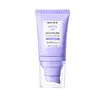What's inside
What's inside
 Key Ingredients
Key Ingredients

 Benefits
Benefits

 Concerns
Concerns

 Ingredients Side-by-side
Ingredients Side-by-side

Water
Skin ConditioningEthylhexyl Methoxycinnamate
UV AbsorberDiethylamino Hydroxybenzoyl Hexyl Benzoate
UV FilterButylene Glycol
HumectantMethyl Methacrylate Crosspolymer
Ethylhexyl Triazone
UV AbsorberBis-Ethylhexyloxyphenol Methoxyphenyl Triazine
Skin ConditioningGlycereth-26
HumectantEthylhexyl Palmitate
EmollientIsononyl Isononanoate
EmollientDimethicone
EmollientFomes Officinalis Extract
Skin ProtectingCetyl Alcohol
EmollientGlyceryl Stearate
Emollient1,2-Hexanediol
Skin ConditioningSorbitan Oleate
EmulsifyingSilica
AbrasiveHydroxyacetophenone
AntioxidantSodium Polyacrylate
AbsorbentPEG-75 Stearate
Acrylates/C10-30 Alkyl Acrylate Crosspolymer
Emulsion StabilisingPotassium Cetyl Phosphate
EmulsifyingTocopheryl Acetate
AntioxidantCeteth-20
CleansingSteareth-20
CleansingEctoin
Skin ConditioningAvena Sativa Kernel Extract
AbrasiveZinc PCA
HumectantSodium Hydroxide
BufferingXanthan Gum
EmulsifyingGentiana Scabra Root Extract
Skin ConditioningPhenoxyethanol
PreservativeDisodium EDTA
Tocopherol
AntioxidantPEG-40 Hydrogenated Castor Oil
EmulsifyingBHT
AntioxidantPentylene Glycol
Skin ConditioningWater, Ethylhexyl Methoxycinnamate, Diethylamino Hydroxybenzoyl Hexyl Benzoate, Butylene Glycol, Methyl Methacrylate Crosspolymer, Ethylhexyl Triazone, Bis-Ethylhexyloxyphenol Methoxyphenyl Triazine, Glycereth-26, Ethylhexyl Palmitate, Isononyl Isononanoate, Dimethicone, Fomes Officinalis Extract, Cetyl Alcohol, Glyceryl Stearate, 1,2-Hexanediol, Sorbitan Oleate, Silica, Hydroxyacetophenone, Sodium Polyacrylate, PEG-75 Stearate, Acrylates/C10-30 Alkyl Acrylate Crosspolymer, Potassium Cetyl Phosphate, Tocopheryl Acetate, Ceteth-20, Steareth-20, Ectoin, Avena Sativa Kernel Extract, Zinc PCA, Sodium Hydroxide, Xanthan Gum, Gentiana Scabra Root Extract, Phenoxyethanol, Disodium EDTA, Tocopherol, PEG-40 Hydrogenated Castor Oil, BHT, Pentylene Glycol
Water
Skin ConditioningEthylhexyl Methoxycinnamate
UV AbsorberNiacinamide
SmoothingButyl Methoxydibenzoylmethane
UV AbsorberAluminum Starch Octenylsuccinate
AbsorbentPhenoxyethanol
PreservativeCetearyl Olivate
Propanediol
SolventButylene Glycol
HumectantOctocrylene
UV AbsorberAcrylates/C10-30 Alkyl Acrylate Crosspolymer
Emulsion StabilisingSorbitan Olivate
EmulsifyingPolymethyl Methacrylate
Aminomethyl Propanol
BufferingAllantoin
Skin ConditioningPanthenol
Skin ConditioningSalicylic Acid
MaskingXanthan Gum
EmulsifyingTriethylene Glycol
MaskingEthylhexyl Triazone
UV AbsorberTetrasodium EDTA
Lecithin
EmollientBHT
AntioxidantWater, Ethylhexyl Methoxycinnamate, Niacinamide, Butyl Methoxydibenzoylmethane, Aluminum Starch Octenylsuccinate, Phenoxyethanol, Cetearyl Olivate, Propanediol, Butylene Glycol, Octocrylene, Acrylates/C10-30 Alkyl Acrylate Crosspolymer, Sorbitan Olivate, Polymethyl Methacrylate, Aminomethyl Propanol, Allantoin, Panthenol, Salicylic Acid, Xanthan Gum, Triethylene Glycol, Ethylhexyl Triazone, Tetrasodium EDTA, Lecithin, BHT
 Reviews
Reviews

Ingredients Explained
These ingredients are found in both products.
Ingredients higher up in an ingredient list are typically present in a larger amount.
Acrylates/C10-30 Alkyl Acrylate Crosspolymer is a synthetic polymer. It is used to thicken and improve the texture of products. Due to its properties, it can prevent water and oil ingredients from separating.
BHT is a synthetic antioxidant and preservative.
As an antioxidant, it helps your body fight off free-radicals. Free-radicals are molecules that may damage your skin cells.
As a preservative, it is used to stabilize products and prevent them from degrading. Specifically, BHT prevents degradation from oxidation.
The concerns related to BHT come from oral studies; this ingredient is currently allowed for use by both the FDA and EU.
However, it was recently restricted for use in the UK as of April 2024.
Learn more about BHTButylene Glycol (or BG) is used within cosmetic products for a few different reasons:
Overall, Butylene Glycol is a safe and well-rounded ingredient that works well with other ingredients.
Though this ingredient works well with most skin types, some people with sensitive skin may experience a reaction such as allergic rashes, closed comedones, or itchiness.
Learn more about Butylene GlycolEthylhexyl Methoxycinnamate is an organic compound that provides UVB protection. It often goes by the more common name of octinoxate. It is created from methoxycinnamic acid and 2-ethylhexanol.
Ethylhexyl Methoxycinnamate absorbs UVB rays with wavelengths between 280-320 nm. UV absorbers protect your skin by using chemical reactions to convert UV rays into heat and energy.
UVB (290-320 nm) rays emit more energy than UVA rays. They are capable of damaging DNA, causing sunburns and are thought to be linked to skin cancer.
The state of Hawaii has banned sunscreens containing octinoxate due to its potential impact on coral reefs. More research is needed to bridge gaps in this research. The European Union allows higher levels of octinoxate in sunscreens than the US and Australia.
Ethylhexyl Methoxycinnamate is oil soluble. It is not stable and may lose efficacy when exposed to sunlight.
Learn more about Ethylhexyl MethoxycinnamateEthylhexyl Triazone is a modern chemical sunscreen that protects from UV-B radiation.
It is the most effective of existing UV-B filters, as it provides the highest level of photo-stable absorption. It protects from the entire UV-B range (280 to 320nm), with it's highest level of protection at 314nm.
Ethylhexyl Triazone is oil soluble, oderless and colorless, which mean it is able to be incorporated into a variety of different formulations.
It is not currently available within the United States due to slow changing FDA regulations. Outside of the US, it is used in formulations at concentrations up to 5%.
Learn more about Ethylhexyl TriazonePhenoxyethanol is a preservative that has germicide, antimicrobial, and aromatic properties. Studies show that phenoxyethanol can prevent microbial growth. By itself, it has a scent that is similar to that of a rose.
It's often used in formulations along with Caprylyl Glycol to preserve the shelf life of products.
Water. It's the most common cosmetic ingredient of all. You'll usually see it at the top of ingredient lists, meaning that it makes up the largest part of the product.
So why is it so popular? Water most often acts as a solvent - this means that it helps dissolve other ingredients into the formulation.
You'll also recognize water as that liquid we all need to stay alive. If you see this, drink a glass of water. Stay hydrated!
Learn more about WaterXanthan gum is used as a stabilizer and thickener within cosmetic products. It helps give products a sticky, thick feeling - preventing them from being too runny.
On the technical side of things, xanthan gum is a polysaccharide - a combination consisting of multiple sugar molecules bonded together.
Xanthan gum is a pretty common and great ingredient. It is a natural, non-toxic, non-irritating ingredient that is also commonly used in food products.
Learn more about Xanthan Gum